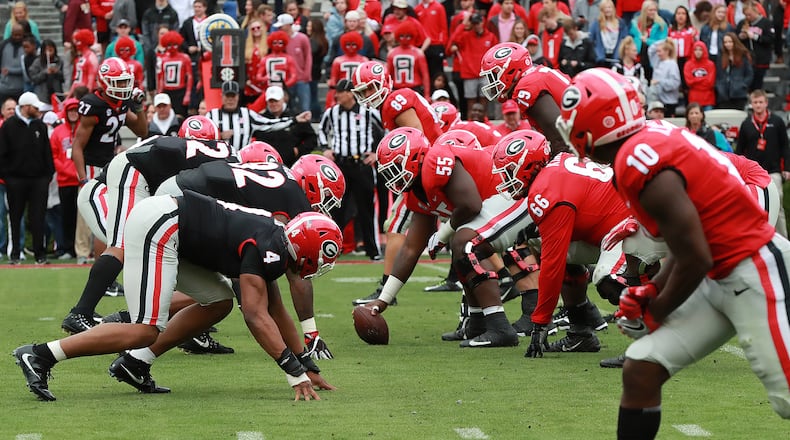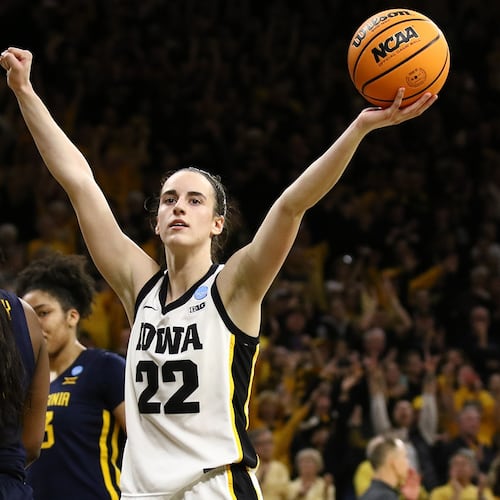The Big Ten canceled non-conference games. The Pac-12 did likewise. Forty percent of the Power 5 has declared that at least some scheduled football games cannot be played.
SEC commissioner Greg Sankey told ESPN Radio on Saturday his concern about the 2020 season is "high to very high." In case anyone missed the point, he took to Twitter: "Yep, that's exactly what I said ... The direct reality is not good." This came two days after Georgia athletic director Greg McGarity told the ol' AJC: "Things are trending in the wrong direction."
Everyone involved with college sports would like to play football in 2020. At issue is whether that’s even possible and, if so, whether it’s the right thing, public-health-wise, to do. Nobody – well, nobody outside the Ivy and Patriot Leagues – has flat-out said, “We can’t make it work this fall,” but it’s clear the game’s stewards are preparing us for what’s apt to happen (or, in this case, not happen) soon.
Not playing in 2020 doesn’t necessarily mean that a 2020 season, of sorts, won’t be played. It just might happen in the spring of 2021. Nobody really wants that, but if the choice is no-football-period or some-sort-of-football, some conferences might well choose the latter. Nobody makes any money if there are are no games, and – you know this already – college football makes lots of money.
So, just for today, let’s pretend that college football decides to push its fall season into the spring of next year. (Which could make for TWO football seasons in 2021, about which more in a bit.) How might that look?
First question: When we say “spring,” what do we mean? A normal college season sees practice begin in late July, with games starting in late August/early September and running through November/early December. Then it takes a month off and stages its postseason. That’s roughly 5-1/2 months.
It’s impossible to imagine football trying to jam 12 regular-season games plus conference championships plus bowls plus playoff into the first five months of 2021, especially since no football in fall 2020 would almost certainly mean no football practice in 2020. You’d need at least January for training camp, and do you really want to be playing outdoor football in February? (Even the NFL doesn’t dare.)
The belief is that any spring football season would start in March and end in May. That would mean no non-conference games for anybody. It also would mean football commencing at a time traditionally reserved for March Madness, which would tick off basketball folks to no end, but whaddaya gonna do?
(Note: We’re not sure there’ll be college basketball in 2020-21, either. We’re not sure of anything.)
So, then: Eight/nine college football games – perhaps with fans in attendance, perhaps not – commencing in March and running through May. Then (maybe) some conference title games and then (almost certainly) the four-team playoff. That surely would be it. There would be no bowls because it would nuts to act as if a delayed season is like all other seasons. (Imagine the Tournament of Roses Parade on Memorial Day.) If it happens at all, a spring season would need to be quick and dirty.
Next question: What big sporting news is made at the end of April? Why, the NFL draft. Here we ask: If you’re Trevor Lawrence or Justin Fields and you have a pretty fair idea you’ll be taken at the top of Round 1, do you risk your future by playing football in March/April/May? Would any highly regarded junior/senior?
Next question, and also the biggest: If your only window of opportunity is to start a season two months after it was scheduled to end and conduct it without some, if not most, of the sport’s best players, would you be better served shutting that window and saying, “Thanks, but we’ll wait until fall 2021?”
In a perfect world, maybe. In this rather imperfect world, that would leave much money unmade at a time when Stanford just cut 11 of its 36 sports. It also would mean Lawrence and Fields would never again play college football. (No way they’d wait until 2022 to become draft-eligible.)
If college football can’t be played this fall, there’s no great contingency plan. A spring football season would be at best a pale facsimile of the real thing; at worst it would be XFL-like. The zealots will say, “Any football beats no football,” but let’s wait a while before we have that discussion. Let’s instead mention the elephant in the room, and we don’t mean Alabama’s Big Al.
There might not be a vaccine for COVID-19 by March. The difference would be that, as still scheduled, the college season would carry us into the colder months, when the common flu takes hold. A spring season would lead us into warmer weather. Is that enough of a difference to hold off until March? Maybe. Would that be enough to allow fans to attend games? Possibly.
Final question: What of those who actually play college football? You’d be asking them to work actual games from March through May and then, assuming the scheduled 2021 season is held in 2021, work another bunch of games from September through January. That would be unprecedented. It could well be unhealthy, and not just from a virus standpoint. Is a 21-year-old body equipped to handle a year in which 10 months are devoted to football practice/games?
As Sankey told ESPN: “As a society we owe it to each other to try and be as healthy as we can.” Colleges owe even more to collegians. It would make no sense if, in the effort to work around a pandemic, colleges allow amateur athletes to work at a rate the NFL players union would never allow. It might be possible to pull off a spring football season. It also might be imprudent.
About the Author
The Latest
Featured


